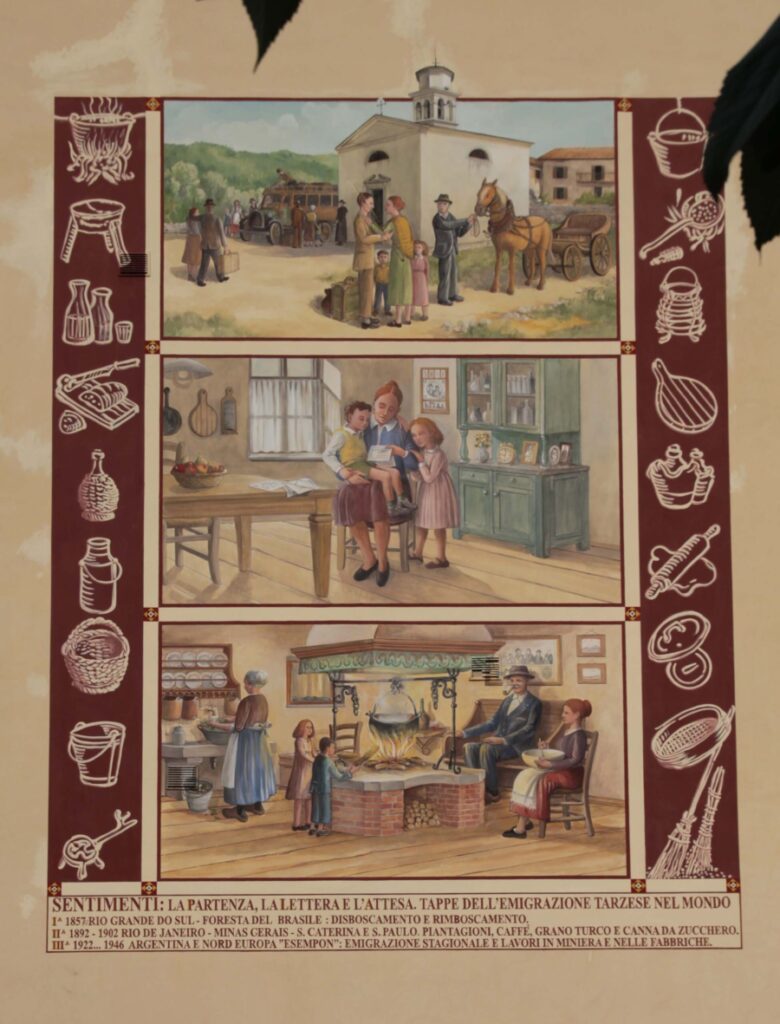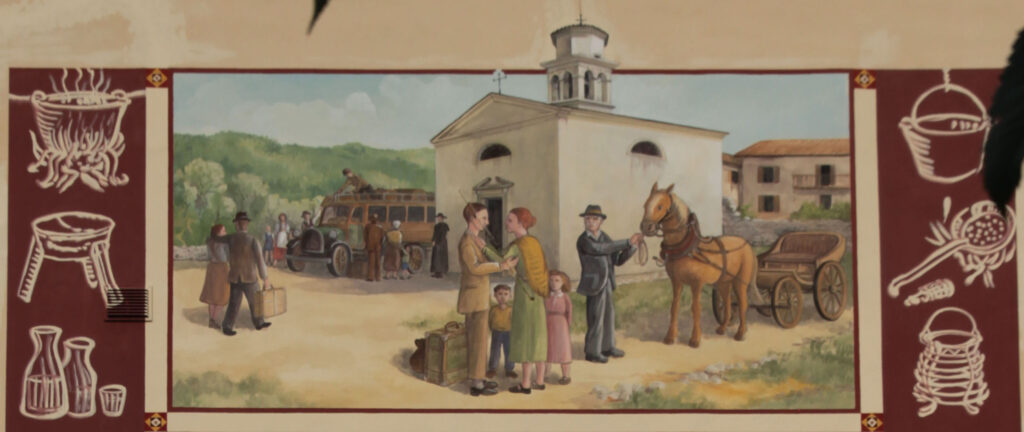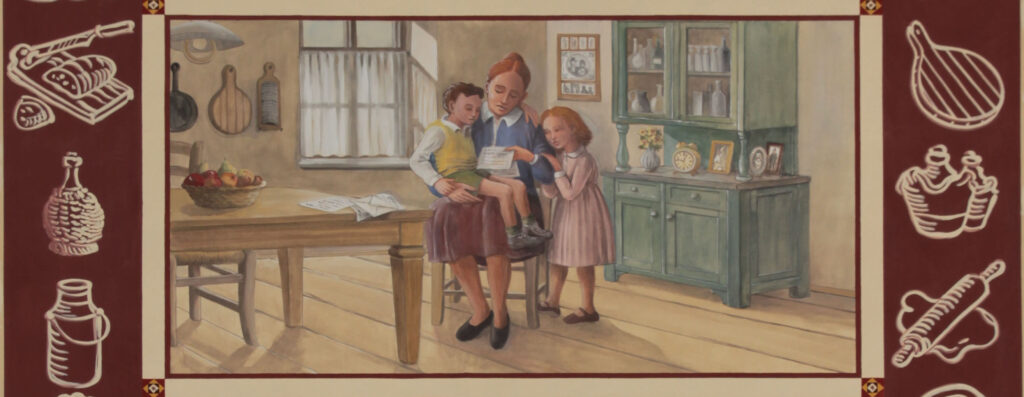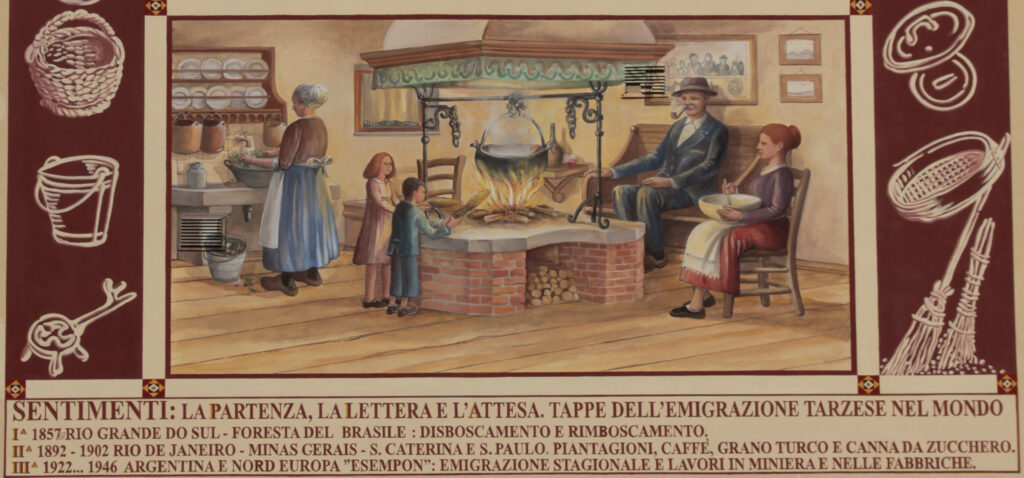
Luogo: località fratta, 124 Tarzo (TV)
La scritta sotto al murales indica i luoghi principali delle 3 emigrazioni dal territorio tarzese:
I^ 1857 RIO GRANDE DO SUL Foresta del Brasile:
Disboscamento e Rimboscamento
II^ 1892-1902 – RIO DE JANEIRO, MINAS GERAIS –
S. CATERINA E S. PAULO:
Piantagioni caffè, granoturco e canna da zucchero
III^ 1922-1946 ARGENTINA E NORD EUROPA “ESEMPON”:
Emigrazione stagionale – lavori in miniera e nelle fabbriche.

L’EMIGRAZIONE
Ubicazione: Loc.Fratta di Tarzo – Casa De Favari-De Polo
Autore: Gabriele Cattarin
Anno realizzazione 2011 – inaugurazione: sabato 30 luglio 2011
Tecnica: Pittura murale con silicati
L’opera, posta sulla facciata dell’abitazione lungo la strada provinciale di Fratta, tratta il tema dell’emigrazione e la rappresenta con tre scene: la partenza, la lettera dall’estero e l’attesa.
L’emigrazione è stato un fenomeno che ha attraversato tutta la nostra nazione e viene doverosamente ricordata omaggiando il sacrificio che rappresenta, con l’annuale FESTA DELL’EMIGRANTE che si è svolta nella frazione di Fratta a partire dall’agosto 1976. Proprio in questo periodo i nostri emigranti “rincasavano” per trascorrere qualche momento al paese natio.
Il murales rappresenta tre distinti momenti che racchiudono tante emozioni:
- LA PARTENZA: doloroso momento di distacco dalla famiglia di origine e inizio di un viaggio lungo ed incerto supportato dalla speranza di trovare fortuna o, quantomeno, una situazione migliore di quella che veniva lasciata. Tanta era la povertà che si lasciava al paese d’origine che qualsiasi altra situazione sarebbe stata probabilmente migliore. Generalmente partivano i giovani uomini forti e lasciavano a casa, con i vecchi genitori, le mogli e figli, nella speranza di poter essere da loro raggiunti dopo aver trovato una sistemazione certa.
- LA LETTERA: Il viaggio poteva durare mesi, tempo in cui non vi era nessuna notizia di chi partiva. Ricevere una lettera dal proprio caro era momento di grande festa, gioia e speranza che potesse davvero aver trovato la fortuna tanto sperata.
- L’ATTESA: attorno al focolare di casa si riunivano i bimbi con i nonni e spesso la madre, che attendono con speranza il ritorno del padre o comunque di chi era partito.
Le tre frasi sotto riportate indicano le varie fasi della nostra emigrazione. La prima ondata che risale alla fine ‘800 la cui meta era il Brasile. La seconda fase dei primi ‘900 che vede come meta l’Argentina e infine la terza che ha coinvolto di più le nazioni europee. I grandi flussi migratori che partivano dai nostri paesi si sono ridotti con lo sviluppo delle nostre industrie nei primi anni ’70.

L’EMIGRAZIONE (The emigration)
Location: Fratta (Tarzo municipality) – Casa De Favari-De Polo
Author: Gabriele Cattarin
Year of creation: 2011 – inauguration: July 30th, 2011
Technique: Wall painting with silicates
The work is located on the facade of the house running parallel to the country road in Fratta and deals with the phenomenon of emigration. The topic is depicted with three scenes: the departure, the letter from abroad and the waiting.
Emigration has been a phenomenon that spread throughout our country and is remembered by honoring the sacrifice it represented with the annual Festa dell’Emigrante (the festival of emigration), which has been taking place in Fratta since August 1976.
The painting depicts three different moments full of emotions:
- The Departure: a painful moment of parting with the family of origin and the beginning of a long voyage full of uncertainties, in the hope to find fortune or, at least, a better life than that having been left behind. So much was the poverty back in one’s motherland that any other situation would have probably been better. Generally young and strong men left behind elderly parents, children and wives, hoping they could catch up after having been assured of a safe accommodation.
- The Letter: the journey could last for months, a time when there was no news of those who had left. Receiving a letter from a beloved one who had emigrated was a moment of celebration, joy and hope that they might have really found the fortune they had been longing for.
- The Waiting: around the hearth the children, grandparents and after the mother got together, waiting hopefully for the return of those who had left.
The three sentences displayed below indicate the various phases of our emigration. The first wave, dating back to the end of the 1800s, had Brazil as the main destination; the second one, at the beginning of the 1900s, was directed mainly toward Argentina; the last and greatest one regarded mainly european nations. The great fluxes of people leaving our territories reduces with the development of our industries at the beginning of the 1970s.

L’EMIGRAZIONE
Die Auswanderung
Standort: Fratta (Tarzo) – Haus De Favari-De Polo
Autor: Gabriele Cattarin
Jahr: 2011 – Eröffnung: Samstag, 30. Juli 2011
Technik: Wandmalerei mit Silikatfarbe
Das Werk befindet sich an der Hausfassade entlang der Provinzstraße von Fratta und behandelt das Thema Migration in drei Szenen: die Abreise, der Brief aus dem Ausland und die Wartezeit.
Die Auswanderung war ein Phänomen, das unser Land durchquert hat und wird von uns am jährlichen Emigrationsfest (Festa dell’emigrante) erinnert, um ihr Opfer zu würdigen. Das Emigrationsfest fand ab August 1976 in Fratta statt, als unsere Emigranten nach Hause kamen, um Zeit im Mutterland zu verbringen.
Das Wandgemälde repräsentiert drei verschiedene Momente, die viele Emotionen umschließen:
– Die Abreise: schmerzliche Trennung von der Familie und Beginn einer langen, unsicheren Reise in der Hoffnung, Glück zu haben und eine bessere Situation zu finden. Alles wäre besser gewesen als die Armut im Herkunftsland. Normalerweise reisten starke junge Männer und sie ließen alte Eltern, Ehefrauen und Kinder zu Hause, bis sie wussten, dass sie eine angemessene Unterkunft hatten. Erst dann ließen sie sich von der ganzen Familie erreichen.
– Der Brief: Die Reise könnte Monate dauern und die Familie wusste nichts von der Person, die gegangen war. Einen Brief von seinem Geliebten zu erhalten war eine Zeit der Freude und der Hoffnung, weil sie vielleicht das erhoffte Glück gefunden hatte.
– Die Wartezeit: Die Kinder mit den Großeltern und oft die Mutter versammelte sich um die Feuerstelle und warten mit Hoffnung auf die Rückkehr des Vaters oder der Ausreißer.
Die folgenden drei Sätze zeigen die verschiedenen Phasen unserer Auswanderung an. Die erste Welle geht auf das Ende ‘800 zurück, deren Ziel Brasilien war. Die zweite Phase geht auf die ersten ‘900 Jahre zurück und sieht Argentinien als Ziel. Die dritte Welle betraf die europäischen Nationen am stärksten. Die großen Migrationsströme aus unseren Ländern sind seit der Entwicklung unserer Industrien in den frühen 70ern zurückgegangen.





